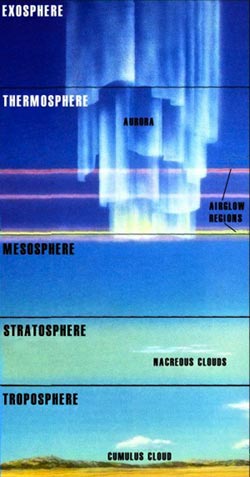This is an old revision of this page, as edited by William M. Connolley (talk | contribs) at 21:49, 21 January 2004 (Remove dubious/pointless first sentence of Pressure section. Rephrase incorrect pressure drop bit.). The present address (URL) is a permanent link to this revision, which may differ significantly from the current revision.
Revision as of 21:49, 21 January 2004 by William M. Connolley (talk | contribs) (Remove dubious/pointless first sentence of Pressure section. Rephrase incorrect pressure drop bit.)(diff) ← Previous revision | Latest revision (diff) | Newer revision → (diff)Earth's atmosphere consists of nitrogen (78.1%) and oxygen (20.9%), with small amounts of argon (0.9%), carbon dioxide (variable, but around 0.035%), water vapor, and other gases. The atmosphere protects life on Earth by absorbing ultraviolet solar radiation and reducing temperature extremes between day and night. 75% of the atmosphere exists within 11 km of the planetary surface.
As the atmosphere has no abrupt cut-off, but rather thins gradually with increasing altitude, there is no definite boundary between the atmosphere and outer space. In the United States, persons who travel above an altitude of 50 miles (80 kilometres) are designated as astronauts. 400,000 feet (75 miles or 120 kilometres) marks the boundary where atmospheric effects become noticeable during re-entry. The altitude of 100 kilometres or 62 miles is also frequently used as the boundary between atmosphere and space.

Temperature and the atmospheric layers
The temperature of the Earth's atmosphere varies with altitude; the relationship between temperature and altitude varies between the different atmospheric layers:
- troposphere - 0 - 7/17 km, temperature decreasing with height.
- stratosphere - 7/17 - 50 km, temperature increasing with height.
- mesosphere - 50 - 80/85 km, temperature decreasing with height.
- thermosphere - 80/85 - 640+ km, temperature increasing with height.
The boundaries between these regions are named the tropopause, stratopause and mesopause.
The average temperature of the atmosphere at the surface of earth is 14 °C.
Pressure
Atmospheric pressure is a direct result of the weight of the air. This means that air pressure varies with location and time because the amount (and weight) of air above the earth varies with location and time. Atmospheric pressure drops by ~50% at an altitude of about 5 km (equivalently, about 50% of the total atmospheric mass is within the lowest 5 km). The average atmospheric pressure, at sea level, is about 101.3 kilopascals (about 14.7 pounds per square inch).
Density and mass
The density of air at sea level is about 1.2 kilograms per cubic meter. This density decreases at higher altitudes at approximately the same rate that pressure decreases (but not quite as fast). The total mass of the atmosphere is about 5.1 × 10 kg, a tiny fraction of the earth's total mass.
Various atmospheric regions
Atmospheric regions are also named in other ways:
- ionosphere - the region containing ions: approximately the mesosphere and thermosphere up to 550 km.
- exosphere - above the ionosphere, where the atmosphere thins out into space.
- ozone layer - or ozonosphere, approximately 10 - 50 km, where stratospheric ozone is found.
- magnetosphere - the region where the Earth's magnetic field interacts with the solar wind from the Sun. It extends for tens of thousands of kilometers, with a long tail away from the Sun.
- Van Allen radiation belts - regions where particles from the Sun become concentrated.
The "Evolution" of the Earth's atmosphere
The history of the Earth's atmosphere is only poorly understood prior to one billion years ago, but the following presents a plausible sequence of events. This remains an active area of research.
The modern atmosphere is sometimes referred to as its "third atmosphere", in order to distinguish the current chemical composition from two notably different compositions. The original atmosphere was primarily helium and hydrogen; heat (from the still molten crust, and the sun) dissipated this atmopshere.
About 3.5 billion years ago, the surface had cooled enough to form a crust, still heavily populated with volcanoes which released steam, carbon dioxide, and ammonia. This led to the "second atmosphere"; which was, primarily, carbon dioxide and water vapor, with some nitrogen but virtually no oxygen. This second atmosphere had ~100 times as much gas as the current atmosphere. It is generally believed that the greenhouse effect, caused by high levels of carbon dioxide, kept the Earth from freezing.
During the next few billion years, water vapor condensed to form rain and oceans, which began to dissolve carbon dioxide. Approximately 50% of the carbon dioxide would be absorbed into the oceans. Photosynthesizing plants would evolve and convert carbon dioxide into oxygen. Over time, excess carbon became locked in fossil fuels, sedimentary rocks (notably limestone), and animal shells. As oxygen was released, it reacted with ammonia to create nitrogen; in addition, bacteria would also convert ammonia into nitrogen.
As more plants appeared, the levels of oxygen increased significantly (while carbon dioxide levels dropped). At first it combined with various elements (such as iron), but eventually oxygen accumulated in the atmosphere — resulting in mass extinctions and further evolution. With the appearance of an ozone layer (a compound of oxygen atoms) lifeforms were better protected from ultraviolet radiation. This oxygen-nitrogen atmosphere is the "third atmosphere".
Global warming
See Global Warming, Historical temperature record, IPCC and Anthropogenic Climate Change.